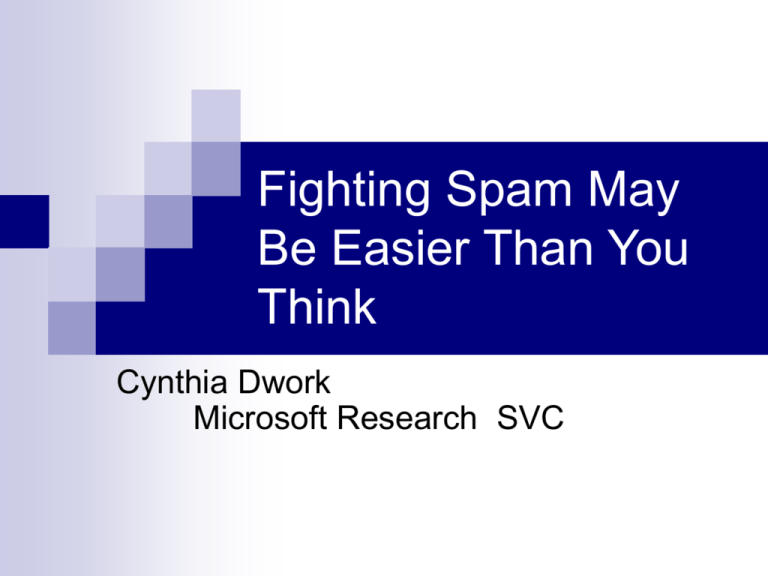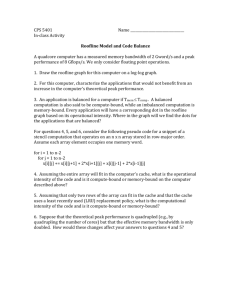Fighting Spam May Be Easier Than You Think
advertisement

Fighting Spam May
Be Easier Than You
Think
Cynthia Dwork
Microsoft Research SVC
Why?
Huge problem
Industry: costs in worker attention, infrastructure
Individuals: increased ISP fees
Hotmail: huge storage costs, (was?) 65-85%
FTC: fraud, confidence crimes
Ruining e-mail, devaluing the Internet
2
Principal Techniques
Filtering
Everyone: text-based
Brightmail: decoys; rules updates
Microsoft Research: (seeded) trainable filters
SpamCloud: collaborative filtering
SpamCop, Osirusoft, etc: IP addresses, proxies, …
Make Sender Pay
Computation [Dwork-Naor’92; Back’97]
Human Attention [Naor’96, SRC patent]
Money [Gates’96] and Bonds [Vanquish]
3
Outline
The Computational Approach (“puzzles”)
Overview; economic considerations
Burrows’ suggestion: memory-bound functions
Social and Technical issues
Turing Tests
Architectures
Point-to-Point & Amanuensis
Centralized Ticket Server
Deeper Discussion of Memory-Bound Functions
3 Approaches and Small-Space Cryptanalyses
New Proposal (joint with A. Goldberg and M. Naor)
4
Computational Approach
If I don’t know you:
Prove you spent ten seconds CPU time,
just for me, and just for this message
User Experience:
Automatically and in the background
Checking proof extremely easy
All
unsolicited mail treated equally
5
Economics
(80,000 s/day) / (10s/message) = 8,000 msgs/day
Hotmail’s billion daily spams:
125,000
CPUs
Up front capital cost just for HM: circa $150,000,000
The spammers can’t afford it.
6
Who Are the Spammers?
"Most of the spammers are not wealthy
people," said Stephen Kline, a lawyer for
the New York State attorney general's
office.
7
8
Who Are the Spammers?
Spamhaus ROKSO 100/90%
Circa 300 people total; very top few spammers
make a few million/year (F. Krueger, SMN; also,
see the recent articles about Alan Ralsky)
Comparison: FastClick, with 30% of popunder
market, has profit of $2 mil/yr (income of $4
mil/yr)
Biggest publicly traded company: eUniverse ($6
mil profit); list of 108 “good” names
Hit ratio: 10-6 to 10-5
9
Cryptographic Puzzles
Hard to compute; f(S,R,t,nonce) can’t be amortized
lots of work for the sender
Easy to check “z = f(S,R,t,nonce)”
little work for receiver
Parameterized to scale with Moore's Law
easy to exponentially increase computational cost, while
barely increasing checking cost
Can be based on (carefully) weakened signature
schemes, hash collisions
Can arrange a “shortcut” for post office
10
Burrows’ Suggestion
CPU speeds vary widely across machines, but
memory latencies vary much less (10+ vs 4)
So: design a puzzle leading to a large number of
cache misses
11
Social Issues
Who chooses f?
One global f? Who sets the price?
Autonomously chosen f’s?
How is f distributed (ultimately)?
Global f built into all mail clients? (1-pass)
Directory? Query-Response? (3-pass)
12
Technical Issues
Distribution Lists (!)
Awkward Introductory Period
Old versions of mail programs; bounces
Very Slow/Small-Memory Machines
Can implement “post office” (CPU), but:
Who gets to be the Post Office? Trust?
Cache Thrashing (memory-bound)
The Subverters
13
Turing Tests: Payment in Kind [N’96;SRC]
CAPTCHAs (Completely Automated Public T. test
for telling Computers and Humans Apart)
Defeat automated account generation
5-10% drop in subscription rate
Teams of conjectured-humans (8-hour shifts)
Yes: Distorted images of simple word
No: ``Find 3 words in image with multiple
overlapping images of words''
Others: subject classification, audio
M. Blum: people have done preprocessing
14
Social and Technical Issues
Social (especially in enterprise setting)
ADA, S.508 (blind, dyslexic)
Not ``professional''
Productivity cost: context switch (may be mitigated in
architecture supporting pre-computation)
Wrong direction: we should offload crap onto machines
Technical
No theory; if broken, can’t scale.
Idrive, AltaVista, broken [J]
EZ Gimpy (Yahoo!) broken [M+]
15
Turing Test Economic Issues
Human time in poor country has roughly
same cost as computer time (even if 8/5 wk)
Also
need computer, but it can be slow, cheap
10s same ballpark as some Turing tests
Suppose we’re wrong about cost (a few
hundredths of a cent), and really the price
should be 1 cent
1-cent
challenge costs 2 minutes. No one not
being paid would dream of submitting to this.
16
Cycle Stealing
Stealing cycles from humans: Pornography
companies require random users to solve a
CAPTCHA before seeing the next image [vABL]
Worse for computational challenges
Economics: lots of currency means currency
is devalued. Prices go up.
There are lots of cycles, but anyone can buy
them. Can go into business brokering cycles.
17
Point-to-Point Architecture
Sender client
S
m, f(S,R,t,nonce)
Recipient client
R
(Ideal Message Flow)
Single-pass “send-and-forget”
Can augment with amanuensis to handle slow machines
Can add post office / pricing authority to handle money payments
Time mostly used as nonce for avoiding replays (cache tags,
discard duplicates; time controls size of cache)
18
Here to There (and There’)
m
Ignorant Sender
S
bounce
Spam-Protected
Recipient
release m
R
Three e-mail messages
R’s mail client caches m, S, R, t, nonce
Bounce (viral marketing opportunity)
html attachment with Java Script for f
contains parameters for f (S, R, t,nonce)
clicking on link causes computation, sending e-mail
(optional) link for download of client software
19
Point-to-Point: Issues
Social
Senders trust code (transition period)?
(Who gets to be a pricing authority?)
Technical
No pre-computation possible (slow machines)
Function update requires new download
Sender’s browser must be configured for
sending e-mail (transition period)
20
Remark: Web-Based Mail
Computation done by client (applet or
JavaScript)
Verification and safelist checking done by
server
21
Ticket Server
Ticket Server
[ABBW]
4,5
HTTP
Ticket
OK?
HTTP
Get
Ticket
Kit
1,2
Recipient
Server
3
(Ideal Message Flow)
Ticket kit = (#, puzzle)
Ticket = (#, response)
Any payment method
Tickets may be accumulated in
advance (pre-computation).
Useful if price is high.
Refunds (not shown)
Centralization eases updates
SMTP
MSG + Ticket
Sender
22
Social and Technical Issues
Social
Who gets to be a ticket server? Trust? Privacy?
Federation?
Trust code (transition period)
Technical
Complex; 5 flows (7 with refund)
T may be on different continent than S, R
Target of choice for subverters
23
Memory-Bound Functions [ABMW’02]
Devilish model!
assume cache size (of spammer’s big
machine) is half the size of memory (of
weakest sending machine)
must avoid exploitation of locality, cache lines
(factors of 64 or even 16 matter)
watch out for low-space crypto attacks
24
Meet in Middle (eg, using DES)
Input: x, y partially specified K1, K2
Output: K1, K2
Si = {keys consistent with Ki }
Create table T with all EK1(x),
(so |T| = |S1|)
8 K2 2 S2:
x
DES
K1
compute z=(EK2)-1 (y)
check if z 2 T
DES
y
K2
Optimism: need lots of space
to store T; won’t fit in cache;
hard to generate the z’s in
useful order
25
Analysis of Meet-in-the-Middle
Tradeoff: cache size c < |S1| yields time
proportional to |S1|¢|S2|/c with no cache misses
Sequentiality attacks [AB]: Once T is prepared,
cache-sized blocks can be loaded sequentially.
Luck: challenge may be resolved in cache.
Example: if c = |S1|/4 then there is a ¼ chance of
resolution with no further cache misses once the
cache has been loaded with the first block of T.
26
Subset Sum
Input: Random 2k-bit numbers a1, … , a2k, T
Output: subset of ai’s summing to T mod 22k
Optimism:
LLL
lattice basis reduction
dynamic programming: simultaneously O(2k)
time and space
Analysis: killed by Schroeppel and Shamir,
Simultaneous T=O(2k), S=O(2k/2)
27
Easy Functions [ABMW’02]
0 1 2 ...
(simplified construction)
f: n bits to n bits, easy
Given xk 2 range(f(k)), find a
pre-image with certain
properties
Hope: best solved by building
table for f-1 and working back
from xk
Choose n=22 so f -1 fits in
small memory, but not in
cache
Optimism: xk is root of tree of
expected size k2
X0
...
...
2 n-1
Xk-1
Xk
28
Analysis of Easy Functions
Vulnerable to T/S tradeoffs for inverting
functions [Hellman; Fiat-Naor]
TS2
= O(N2)cpuf
Cost of inverting f without memory accesses is
only O(4) times cost of computing f (S=N/2); no
cache misses!
As clock speeds increase, must increase cpuf
29
Interpretation:
Easy-Function challenges are cpu-bound, but
their structure (the cpu-avoiding, table-lookup
method) dampens the effect of Moore’s Law.
Verifier’s costs increase with Moore’s Law
k ¢ cpuf cycles
30
Our Approach
The sender makes a sequence of random
memory accesses and sends a proof of having
done so to the receiver, who needs a small
number of accesses for verification. The
memory access pattern leads to many cache
misses, making the computation memory-bound.
How to generate random-looking access pattern?
What is an easily verifiable proof?
31
High Level Description
Shared array of random numbers T
A path is a sequence of inherently sequential
accesses to T
Sender must search a set S of paths to find a
desired path
Process is message/recipient dependent
Sender sends a proof of finding desired path to
receiver, who must verify
Ratio of sender/receiver work is S
32
Incompressibility and RC4
Big (222) Fixed-Forever Truly Random T
Model walk on prg of RC4 stream cipher
Intuition:
Use the pr bit stream (seeded by message) to choose
entries of T to access.
These, in turn, affect the stream (defending against preprocessing to order T so as to exploit locality).
33
RC4 (Partial Description)
Initialize A to pseudorandom permutation
of {1, 2, …, 256}
using a seed K
Initialize Indices:
i = 0; j = 0
PR generation loop:
i=i+1
j = j + A[i]
Swap (A[i], A[j]);
Output z = A[A[i] + A[j]]
34
DGN: Initializing A and Basic Step
Fixed-Forever truly
random A of size 256;
32-bit words
Given m and trial
number i, compute
strong cryptographic
256-word mask M.
Set A = M © A.
c = A mod 222
Initialize Indices:
d=0; e=0
Walk:
d=d+1
e = e + A[d]
A[d] = A[d] © T[c]
Swap (A[d], A[e])
c = T[c] © A[A[e] + A[d]]
35
Side by Side
Generate pseudorandom permutation
of {1, 2, …, 256}
using a seed K
Fixed-Forever truly
random A of size 256;
32-bit words
Given m and trial
number i, compute
strong cryptographic
256-word mask M.
Set A = M © A.
c = A mod 222
36
Side by Side
Initialize Indices:
i = 0; j = 0
PR generation loop:
i=i+1
j = j + A[i]
Swap (A[i], A[j])
Output z = A[A[i]+A[j]]
Initialize Indices:
d=0; e=0
Walk:
d=d+1
e = e + A[d]
A[d] = A[d] © T[c]
Swap (A[d], A[e])
c = T[c] © A[A[e] + A[d]]
37
Full DGN
E: factor by which computation cost
exceeds verification
L: length of walk
Trial i succeeds if hash of A after ith walk
ends in 1+log2E zeroes (expected number
of trials is E).
Verification: trace the walk (L memory
accesses)
38
Parallel Attack [ABMW]
Process many paths in parallel; do
memory accesses in sorted order to take
advantage of cache lines
Say attack succeeds if the number of
occupied cache lines is ¾ the number of
parallel paths (ie, reduce #lines by 1/3)
Probabilistic analysis shows attack needs
over 217 paths, but only 214 different A’s fit
into 16MB cache
39
Parameters
Want ELt=10s, where
L = path length
t = memory latency = 0.2 microseconds
Reasonable choices:
E = 24,000, L = 2048
40
Intuition for Why it Works
Fight tradeoffs using incompressible T
Fight preprocessing of T by using message+trial
dependent A in computing walk
Fight preprocessing of A by modifying using T
Fight locality: choice of E and trial-dependence
of A
Good statistics for walks by analogy with
statistics for heavily-studied RC4 (?)
41
Lower Bound for Abstract Version
General formal model
Abstraction of our algorithm using
idealized hash functions
Proof that amortized number of cache
misses is linear in desired number
42
Summary
Discussed computational approach, Turing
tests, economics, cycle-stealing
Briefly mentioned two architectures
Examined difficulties of constructing
memory-bound pricing functions and
proposed a new one designed to avoid
these difficulties
Lower bounds for idealization.
43
Future Work and Open Questions
Stanford undergrads just completed
simple Outlook proxy and Unix filters; webbased implementation in progress; next
steps: handle bounces, add signatures
Distribution Lists
Good MB functions with short descriptions
(will subset product work)?
44






